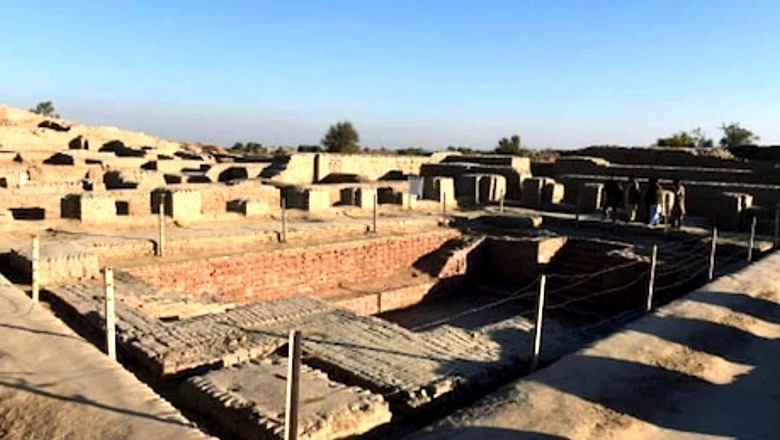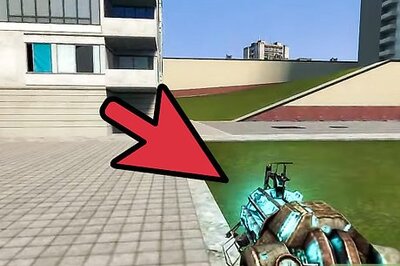
views
With floods in Pakistan wreaking havoc in the country, the famous archeological site of Mohenjo-Daro which is considered to be one of the best preserved early urban settlements in South Asia, may lose it’s UNESCO world heritage site status with damage to the site in the past weeks.
The archaeological site dates back 4,500 years in flood-stricken Pakistan, where an unprecedented monsoon season has killed hundreds of people.
But what is the significance of the site and why is it in danger? News18 Explains:
The History of Mohenjo-Daro
The Mohenjo-daro ruins, located in southern Sindh province near the Indus River and designated as a UNESCO World Heritage Site, are among the best preserved urban settlements in South Asia. They were discovered in 1922, and the disappearance of its civilisation, which coincided with those of ancient Egypt and Mesopotamia, remains a mystery.
Mohenjo-daro is an archaeological site located 80 kilometres southwest of Sukkur city. The site contains the ruins of one of the two main centres of the Indus civilization, the other being Harappa, which is located 640 kilometres to the northwest in Pakistan’s Punjab province.
Indus Valley Civilization sites have been discovered across a wide range of terrain, from Sutkagen Dor in Balochistan near the Pakistan-Iran border to Rakhigarhi in Haryana’s Hisar district, and from Manda in Jammu to Daimabad in Maharashtra. Other important Harappan civilization sites in India include Lothal and Dholavira in Gujarat, and Kalibangan in Rajasthan.
The Mohenjo-Daro ruins were unknown until Rakhal Das Banerji of the Archaeological Survey of India visited the site in 1920 and began excavating the following year. Excavation continued in stages until 1964-65, with only a small portion of the site excavated even now.
The ancient site’s significance was first recognised in 1922, a year after Harappa was discovered. Mohenjo-daro, which means “the mound of the dead,” was the largest city of the Indus civilization.
The site is famous for its intricate town planning, including street grids with brick pavements, developed water supply, drainage, and covered sewerage systems, toilet-equipped homes, and monumental structures such as the Great Granary and the Great Bath. Mohenjo Daro had between 30,000 and 60,000 residents at its peak, with a highly evolved social organisation.
Mohenjo Daro, along with Harappa, is the most well-known site of the bronze age urban civilization that flourished in the Indus Valley between roughly 3,300 BC and 1,300 BC, with its’mature’ phase spanning the period 2,600 BC to 1,900 BC. The civilization declined in the middle of the second millennium BC for unknown reasons, including catastrophic climate change.
Why Is the Site Under Threat Now?
Catastrophic climate change is speculated as one of the theories behind the end of the Harappa civilisation. Now, its remains are threatened by extreme weather, as well.
According to a report by Pakistani news portal Dawn, the archaeological ruins of Mohenjo-Daro received record rains totaling 779.5mm from August 16 to 26. It caused significant damage to the site and the partial collapse of several walls, including the stupa dome’s protection wall.
The report quotes sources as saying that the curator of the site stated in a letter to the director of culture, antiquities, and archaeology on August 29 that “we have made efforts to protect the site with our resources.” Other departments — irrigation, roads, highways, and forest — played an important role in protecting the world heritage site, as landlords and farmers had not only installed pipes and cut canals and roads to release water into Mohenjo Daro’s channel. However, rainwater from nearby agricultural lands had filled the disposal channel due to negligence on the part of the aforementioned departments, according to the sources.
The letter stated that this caused a delay in driving out water from the site, and that water had even entered the campus. Following the rains, the official in charge of the site stated, “We are facing another emergency in the form of a consistent rise in the Indus level.”
Although the water level in the Indus is low, the department approached local irrigation officials in vain due to the construction of a metal road on the protection dyke near Mohenjo-Daro, as well as the occurrence of fissures, cavities, and dangerous gullies, according to the letter. It stated that no one had arrived to inspect the site and assess the situation.
How Can the Site Be Saved?
Timely action on the part of authorities seems key.
The archaeology official had requested immediate contact with the irrigation and roads departments to repair bunds, breached canal dykes, and pipe removal, the report by Dawn stated.
The curator has proposed sending experts (conservators and engineers) to assess the damage caused by the downpours. Archaeology officials stationed at Mohenjo Daro are currently repairing the structures that have been damaged.
Read all the Latest Explainers News and Breaking News here




















Comments
0 comment